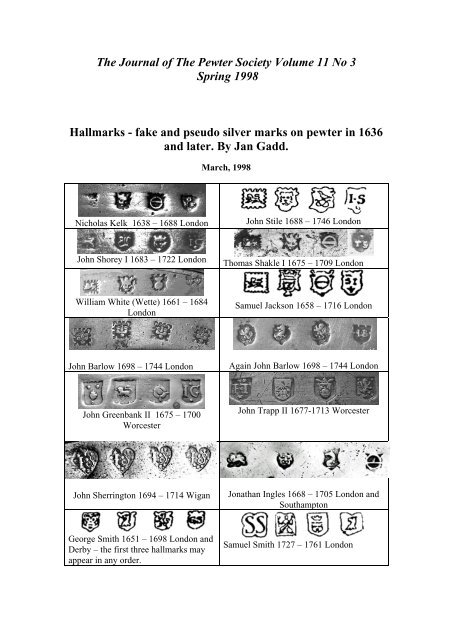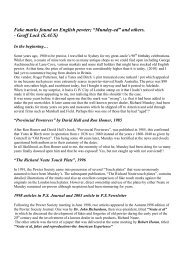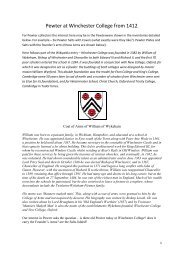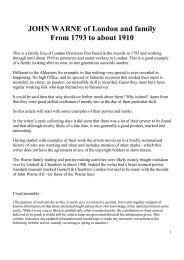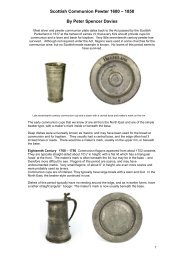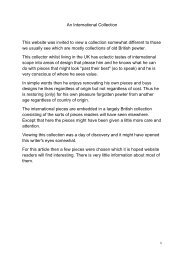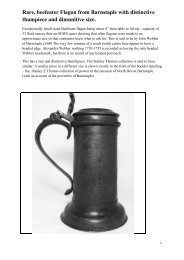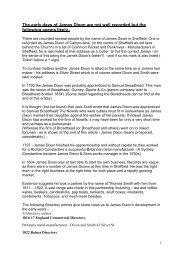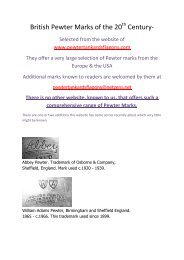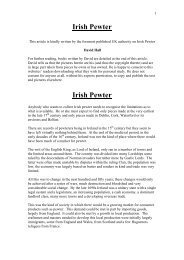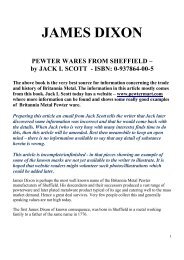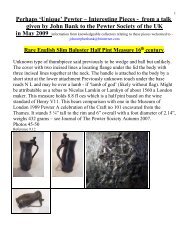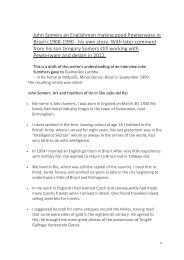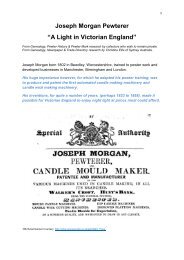Hallmarks - fake and pseudo silver marks on pewter in ... - PewterBank
Hallmarks - fake and pseudo silver marks on pewter in ... - PewterBank
Hallmarks - fake and pseudo silver marks on pewter in ... - PewterBank
Create successful ePaper yourself
Turn your PDF publications into a flip-book with our unique Google optimized e-Paper software.
The Journal of The Pewter Society Volume 11 No 3<br />
Spr<strong>in</strong>g 1998<br />
<str<strong>on</strong>g>Hall<str<strong>on</strong>g>marks</str<strong>on</strong>g></str<strong>on</strong>g> - <str<strong>on</strong>g>fake</str<strong>on</strong>g> <str<strong>on</strong>g>and</str<strong>on</strong>g> <str<strong>on</strong>g>pseudo</str<strong>on</strong>g> <str<strong>on</strong>g>silver</str<strong>on</strong>g> <str<strong>on</strong>g>marks</str<strong>on</strong>g> <strong>on</strong> <strong>pewter</strong> <strong>in</strong> 1636<br />
<str<strong>on</strong>g>and</str<strong>on</strong>g> later. By Jan Gadd.<br />
March, 1998<br />
Nicholas Kelk 1638 – 1688 L<strong>on</strong>d<strong>on</strong><br />
John Stile 1688 – 1746 L<strong>on</strong>d<strong>on</strong><br />
John Shorey I 1683 – 1722 L<strong>on</strong>d<strong>on</strong><br />
Thomas Shakle I 1675 – 1709 L<strong>on</strong>d<strong>on</strong><br />
William White (Wette) 1661 – 1684<br />
L<strong>on</strong>d<strong>on</strong><br />
Samuel Jacks<strong>on</strong> 1658 – 1716 L<strong>on</strong>d<strong>on</strong><br />
John Barlow 1698 – 1744 L<strong>on</strong>d<strong>on</strong><br />
Aga<strong>in</strong> John Barlow 1698 – 1744 L<strong>on</strong>d<strong>on</strong><br />
John Greenbank II 1675 – 1700<br />
Worcester<br />
John Trapp II 1677-1713 Worcester<br />
John Sherr<strong>in</strong>gt<strong>on</strong> 1694 – 1714 Wigan<br />
J<strong>on</strong>athan Ingles 1668 – 1705 L<strong>on</strong>d<strong>on</strong> <str<strong>on</strong>g>and</str<strong>on</strong>g><br />
Southampt<strong>on</strong><br />
George Smith 1651 – 1698 L<strong>on</strong>d<strong>on</strong> <str<strong>on</strong>g>and</str<strong>on</strong>g><br />
Derby – the first three hall<str<strong>on</strong>g>marks</str<strong>on</strong>g> may<br />
appear <strong>in</strong> any order.<br />
Samuel Smith 1727 – 1761 L<strong>on</strong>d<strong>on</strong>
This is the year that the Goldsmiths' Company decided to take acti<strong>on</strong> both aga<strong>in</strong>st an<br />
<strong>in</strong>dividual <strong>pewter</strong>er <str<strong>on</strong>g>and</str<strong>on</strong>g> later <strong>in</strong> 1636 aga<strong>in</strong>st the Pewterer's Company for the<br />
malpractice of us<strong>in</strong>g <str<strong>on</strong>g>silver</str<strong>on</strong>g> hall<str<strong>on</strong>g>marks</str<strong>on</strong>g> <strong>on</strong> <strong>pewter</strong>.<br />
The librarian of the Goldsmiths' Company, Mr David Beasley, has k<strong>in</strong>dly researched<br />
this <strong>in</strong>cident from the Company's archives <str<strong>on</strong>g>and</str<strong>on</strong>g> given his permissi<strong>on</strong> for his<br />
observati<strong>on</strong>s to be published here:<br />
The details of the particular case are recorded <strong>in</strong> the Court M<strong>in</strong>utes of the<br />
Goldsmiths' Company. In the m<strong>in</strong>utes of the 12 January 1635/6 (Court M<strong>in</strong>ute Book<br />
S, part II, fo. 166r) a <strong>pewter</strong> trencher plate bear<strong>in</strong>g the leopard's head, the li<strong>on</strong> <str<strong>on</strong>g>and</str<strong>on</strong>g><br />
the letter "s" was put <strong>in</strong>to the h<str<strong>on</strong>g>and</str<strong>on</strong>g>s of the Wardens who were much c<strong>on</strong>cerned with<br />
the deceit which might practised, (those <str<strong>on</strong>g>marks</str<strong>on</strong>g> resembl<strong>in</strong>g those used <strong>on</strong> all plate <str<strong>on</strong>g>and</str<strong>on</strong>g><br />
vessels of <str<strong>on</strong>g>silver</str<strong>on</strong>g> to be marked at the Hall <strong>in</strong> this year). With the assistance of the<br />
K<strong>in</strong>g's Engraver of the M<strong>in</strong>t, Mr Greene, a warrant was to be processed aga<strong>in</strong>st the<br />
<strong>pewter</strong>er <str<strong>on</strong>g>and</str<strong>on</strong>g> the engraver of the stamps. Some m<strong>on</strong>ths later (7 July 1636) the Clerk<br />
reported that the <strong>pewter</strong>ers <str<strong>on</strong>g>and</str<strong>on</strong>g> the engraver of the stamps had all been prosecuted<br />
<str<strong>on</strong>g>and</str<strong>on</strong>g> had been f<strong>in</strong>ed. He requested that the trencher plate <strong>in</strong> questi<strong>on</strong> be returned to its<br />
owner <str<strong>on</strong>g>and</str<strong>on</strong>g> the counterfeit stamps kept <strong>in</strong> the Company's Treasury. An account of the<br />
Company's petiti<strong>on</strong> to the K<strong>in</strong>g <str<strong>on</strong>g>and</str<strong>on</strong>g> to the Lord Mayor <str<strong>on</strong>g>and</str<strong>on</strong>g> Court of Aldermen<br />
followed. The Pewterers' Company was required to order its members to strike <strong>on</strong>e<br />
mark <strong>on</strong>ly <strong>on</strong> their plate; to c<strong>on</strong>fiscate any stamps which were similar to the<br />
Goldsmiths <str<strong>on</strong>g>and</str<strong>on</strong>g> to h<str<strong>on</strong>g>and</str<strong>on</strong>g> them over to the Goldsmiths; <str<strong>on</strong>g>and</str<strong>on</strong>g> to melt down or deface the<br />
<str<strong>on</strong>g>marks</str<strong>on</strong>g> <strong>on</strong> all <strong>pewter</strong> currently bear<strong>in</strong>g those similar <str<strong>on</strong>g>marks</str<strong>on</strong>g>. (His order was dated the 3<br />
March 1635/6). The <strong>in</strong>dictment <strong>in</strong> Lat<strong>in</strong> followed - the names are <strong>in</strong> Lat<strong>in</strong> but may be<br />
Richard (Radus - Ricardus) - Hall, the engraver, <str<strong>on</strong>g>and</str<strong>on</strong>g> William Artyn, the <strong>pewter</strong>er<br />
(Court M<strong>in</strong>ute Book S, part II fo 209-211r.).<br />
Mr Beasley asked me to po<strong>in</strong>t out that his research covered the earlier period <strong>on</strong>ly <str<strong>on</strong>g>and</str<strong>on</strong>g><br />
that the Lat<strong>in</strong> names could be <strong>in</strong>terpreted differently.<br />
The Pewterers' Company-records suggest that the first offender's name was <strong>in</strong>deed<br />
William Artyne. He was from L<strong>on</strong>d<strong>on</strong> Thorpe <strong>in</strong> L<strong>in</strong>colnshire, was free <strong>in</strong> 1621 <str<strong>on</strong>g>and</str<strong>on</strong>g><br />
had his own shop <strong>in</strong> April 1622. He was apprenticed 1613-1621 to Peter Brocklesby<br />
I, together with Brocklesby's s<strong>on</strong>, Peter Brocklesby II, both guilty of similar <str<strong>on</strong>g>and</str<strong>on</strong>g> other<br />
offences as can be seen below.<br />
It is <strong>in</strong>terest<strong>in</strong>g to note that the engraver, logically, was f<strong>in</strong>ed as well as the <strong>pewter</strong>er!<br />
These engravers <str<strong>on</strong>g>and</str<strong>on</strong>g> die-makers would of course have supplied goldsmiths <str<strong>on</strong>g>and</str<strong>on</strong>g><br />
<strong>pewter</strong>ers alike.<br />
So severe, then, were the prospective c<strong>on</strong>sequences for the <strong>pewter</strong>ers <str<strong>on</strong>g>and</str<strong>on</strong>g> the potential<br />
disgrace for the Pewterers' Company that it must be regarded as highly unlikely that<br />
the practice was carried <strong>on</strong> systematically by officers of the Company <strong>in</strong> the follow<strong>in</strong>g<br />
decades! That the Goldsmiths still kept a watchful eye <strong>on</strong> counterfeit <strong>pewter</strong> is<br />
apparent from their Court Book dur<strong>in</strong>g the years of 1638, 1639 <str<strong>on</strong>g>and</str<strong>on</strong>g> 1643 where the
above Brocklesbys, who seem to have been "serial-offenders", appear twice. Under<br />
the date of July 21, 1638 (not July 20 as noted by Markham) it is stated that the full<br />
Court was not sitt<strong>in</strong>g:<br />
"... but tak<strong>in</strong>g <strong>in</strong>to c<strong>on</strong>siderati<strong>on</strong> the abuse of a <strong>pewter</strong>er <strong>in</strong> Holborn who setteth 4<br />
<str<strong>on</strong>g>marks</str<strong>on</strong>g> up<strong>on</strong> his <strong>pewter</strong> <strong>in</strong> resemblance of the <str<strong>on</strong>g>silver</str<strong>on</strong>g> touch by name Peter Brocklesby<br />
<strong>on</strong>e dish of whose mak<strong>in</strong>g was brought hither by Francis Baker, the engraver, who<br />
compla<strong>in</strong>s of the abuse here<strong>in</strong>, whereup<strong>on</strong> Mr Roberts, <strong>on</strong>e of the Wardens of the<br />
Pewterers was now sent for <str<strong>on</strong>g>and</str<strong>on</strong>g> after the clerk had read unto him the letter from the<br />
Lords of the Council directed unto Sir Christopher Clitherowe, late Lord Mayor of<br />
L<strong>on</strong>d<strong>on</strong> <str<strong>on</strong>g>and</str<strong>on</strong>g> the order of the Court of Aldermen made <strong>in</strong> that behalf he did<br />
acknowledge the same to be a great abuse."<br />
The Master <str<strong>on</strong>g>and</str<strong>on</strong>g> the other Warden Mr Fulham <str<strong>on</strong>g>and</str<strong>on</strong>g> Brooks of the Pewterers' Company<br />
were called <strong>in</strong> after the meet<strong>in</strong>g <str<strong>on</strong>g>and</str<strong>on</strong>g> were "acqua<strong>in</strong>ted with the matter" <str<strong>on</strong>g>and</str<strong>on</strong>g><br />
accompanied the Goldsmiths' Warden (the Master of the Goldsmiths' Company) <strong>on</strong><br />
the search. With such large <str<strong>on</strong>g>and</str<strong>on</strong>g> impressive entourage <strong>on</strong> the march, it was not at all<br />
surpris<strong>in</strong>g to note that Brocklesby had disappeared <str<strong>on</strong>g>and</str<strong>on</strong>g> with him the offend<strong>in</strong>g<br />
<strong>pewter</strong>. The search-party did, however, f<strong>in</strong>d <str<strong>on</strong>g>and</str<strong>on</strong>g> c<strong>on</strong>fiscate <str<strong>on</strong>g>silver</str<strong>on</strong>g> "pouns<strong>on</strong>s" <strong>in</strong> his<br />
absence. Up<strong>on</strong> their return to the Goldsmiths' Hall the <strong>pewter</strong>ers were told to "deal<br />
with the offender at the next meet<strong>in</strong>g." - all this <strong>in</strong> <strong>on</strong>e s<strong>in</strong>gle day!<br />
The Goldsmiths' pursued this case <str<strong>on</strong>g>and</str<strong>on</strong>g> could <strong>on</strong> June 22 (not June 20 as <strong>in</strong><br />
Markham/Prideaux), 1639 report to the Court of Assistants of the Goldsmiths'<br />
Company:<br />
"This day Mr Wardens receiv<strong>in</strong>g <strong>in</strong>formati<strong>on</strong> that Vaughan the graver <strong>in</strong> Kerry Lane<br />
had diverse parcels of <strong>pewter</strong> of <str<strong>on</strong>g>silver</str<strong>on</strong>g> fashi<strong>on</strong> <str<strong>on</strong>g>and</str<strong>on</strong>g> stamps with 4 <str<strong>on</strong>g>marks</str<strong>on</strong>g> <strong>in</strong><br />
resemblance of the <str<strong>on</strong>g>silver</str<strong>on</strong>g> touch....the said <strong>pewter</strong> be<strong>in</strong>g made <str<strong>on</strong>g>and</str<strong>on</strong>g> sold by <strong>on</strong>e Peter<br />
Brocklesby a <strong>pewter</strong>er next to St. Andrews Church <strong>in</strong> Holborn from whence the<br />
Master <str<strong>on</strong>g>and</str<strong>on</strong>g> Wardens of the Pewterers last year took the like stamps <str<strong>on</strong>g>and</str<strong>on</strong>g> delivered<br />
them to the last Wardens of this Company. [The Pewterers' Officers had such<br />
authority, whereas the Goldsmiths' Officers, also present <strong>on</strong> this occasi<strong>on</strong>, had no<br />
authority to <strong>in</strong>terfere with the <strong>in</strong>ventory of a <strong>pewter</strong>er.] And now Mr Wardens<br />
<strong>in</strong>tend<strong>in</strong>g to speak with the Master <str<strong>on</strong>g>and</str<strong>on</strong>g> Wardens of the Pewterers about this abuse<br />
they had noticed that this morn<strong>in</strong>g they were at Pewterers' Hall unto which place Mr<br />
Wardens repaired <str<strong>on</strong>g>and</str<strong>on</strong>g> took the graver with them <str<strong>on</strong>g>and</str<strong>on</strong>g> some pieces of <strong>pewter</strong> of<br />
several sorts by which it appeared that the said Brocklesby made the said <strong>pewter</strong><br />
although his mark was so defaced with the hammer that it was scarce discernible<br />
[probably his own touch rather than the hall<str<strong>on</strong>g>marks</str<strong>on</strong>g>] of which abuse Mr Wardens<br />
compla<strong>in</strong>ed to the Master <str<strong>on</strong>g>and</str<strong>on</strong>g> Warden of the Pewterers it be<strong>in</strong>g an offence aga<strong>in</strong>st an<br />
order of the Lord Mayor <str<strong>on</strong>g>and</str<strong>on</strong>g> the Court of Aldermen made 3rd of March 1635 granted<br />
up<strong>on</strong> a letter directed unto them from the Lords of the Council both which as they are<br />
entered <strong>in</strong> this Company's Court Book at a Court of Assistants holden the 7th of July<br />
1636. Mr Wardens did now course to be read unto them of which the Pewterers had<br />
l<strong>on</strong>g s<strong>in</strong>ce notice by a copy of the said order left with them <str<strong>on</strong>g>and</str<strong>on</strong>g> they did c<strong>on</strong>fess that<br />
the said order was read at their Hall at a General Meet<strong>in</strong>g <str<strong>on</strong>g>and</str<strong>on</strong>g> that the said Brocklesby<br />
had notice thereof the said Master <str<strong>on</strong>g>and</str<strong>on</strong>g> Wardens <str<strong>on</strong>g>and</str<strong>on</strong>g> some of the Assistants of the<br />
Pewterers protest<strong>in</strong>g they do not know any other which attempteth the like <str<strong>on</strong>g>and</str<strong>on</strong>g> they
do promise to give him notice <strong>on</strong>ce more of this compla<strong>in</strong>t <str<strong>on</strong>g>and</str<strong>on</strong>g> require a reformati<strong>on</strong><br />
thereof <str<strong>on</strong>g>and</str<strong>on</strong>g> if he will not obey the said order <str<strong>on</strong>g>and</str<strong>on</strong>g> their government they will assist this<br />
Company <strong>in</strong> their compla<strong>in</strong>t to the Court of Aldermen aga<strong>in</strong>st him but first will<br />
acqua<strong>in</strong>t this Company of their proceed<strong>in</strong>gs with him."<br />
(Vaughan had been commissi<strong>on</strong>ed by an owner to engrave his arms <strong>on</strong> Brocklesby's<br />
<strong>pewter</strong>.)<br />
Peter Brocklesby I appears as an offender <strong>in</strong> 1617-18 (Welch Vol. II, pp.74-75 - <strong>in</strong><br />
1616 accord<strong>in</strong>g to Markham p.111) when he was first ordered to "amend <str<strong>on</strong>g>and</str<strong>on</strong>g> make<br />
perfect his marke" (19th March) <str<strong>on</strong>g>and</str<strong>on</strong>g> later <strong>on</strong> 10th December was found to be <strong>in</strong><br />
breach of the order of the Court of Pewterers to use <strong>on</strong>e touch <strong>on</strong>ly (<strong>on</strong>e touch was<br />
then c<strong>on</strong>fiscated). Peter Brocklesby II was sued by the Pewterers' company "for<br />
arrears of m<strong>on</strong>ey due from him under his wardenship" when <strong>in</strong> 1638 he was serv<strong>in</strong>g<br />
as Upper Warden. This offence could be classified as "embezzlement" <str<strong>on</strong>g>and</str<strong>on</strong>g> was by far<br />
the more serious (Welch Vol II, p.101).<br />
Only <strong>on</strong>e further case is menti<strong>on</strong>ed <strong>in</strong> the Court Book of the Goldsmiths' Company <strong>on</strong><br />
August 31, 1643 when the Assayer, Mr Jacks<strong>on</strong>, produced before the Court a <strong>pewter</strong><br />
pot with hall<str<strong>on</strong>g>marks</str<strong>on</strong>g>.<br />
"... It is therefore ordered that Mr Jacks<strong>on</strong> shall cause another <strong>pewter</strong> pot to be bought<br />
<str<strong>on</strong>g>and</str<strong>on</strong>g> up<strong>on</strong> f<strong>in</strong>d<strong>in</strong>g out the offender then to proceed as shall be further directed by a<br />
Court of Assistants."<br />
The <strong>pewter</strong>er "appears to have been" Butcher of St. Ann's Lane. (Robert B. OP 750 or<br />
Thomas B. OP 751) The vagueness here seems to <strong>in</strong>dicate that the Assayer<br />
purchased the items from a retailer rather than directly from the <strong>pewter</strong>er This case<br />
does not appear to have come to Court <str<strong>on</strong>g>and</str<strong>on</strong>g> it can be assumed that the Assayer was<br />
unsuccessful <strong>in</strong> repeat<strong>in</strong>g the purchase directly from the offend<strong>in</strong>g <strong>pewter</strong>er.<br />
So why is it then that L<strong>on</strong>d<strong>on</strong> sadware often rout<strong>in</strong>ely carry similar hall<str<strong>on</strong>g>marks</str<strong>on</strong>g> over a<br />
l<strong>on</strong>g period of time (The probable start<strong>in</strong>g date of this praxis is much later than the<br />
above fraud cases. Evidence <strong>in</strong> the shape of hallmarked items po<strong>in</strong>t at a time after the<br />
Great Fire of L<strong>on</strong>d<strong>on</strong> or from the Restorati<strong>on</strong> <strong>in</strong> 1660.)<br />
One answer can be deduced from the above. Pewterer Artyne copied the L<strong>on</strong>d<strong>on</strong><br />
Goldsmiths' <str<strong>on</strong>g>marks</str<strong>on</strong>g> exactly, <strong>in</strong>clud<strong>in</strong>g the date-letter "s" for the current year, thus<br />
fraudulently follow<strong>in</strong>g the Ord<strong>in</strong>ance of the Goldsmiths' Company when mark<strong>in</strong>g his<br />
<strong>pewter</strong>ware, <str<strong>on</strong>g>and</str<strong>on</strong>g> therefore also break<strong>in</strong>g the laws of the l<str<strong>on</strong>g>and</str<strong>on</strong>g>! (Had Artyne also<br />
neglected to mark the <strong>pewter</strong> with his own touch, which is not clear, he would then<br />
have been <strong>in</strong> breach of the rules of the Pewterers' Company too.)<br />
C<strong>on</strong>trary to comm<strong>on</strong> belief, it would appear that the Pewterers' Company had very<br />
little to answer for dur<strong>in</strong>g the early period - it was evidently a family affair <strong>in</strong>volv<strong>in</strong>g<br />
run-of-the-mill <str<strong>on</strong>g>fake</str<strong>on</strong>g>rs sell<strong>in</strong>g <str<strong>on</strong>g>silver</str<strong>on</strong>g>-marked <strong>pewter</strong>.<br />
In "A History of Agriculture <str<strong>on</strong>g>and</str<strong>on</strong>g> Prices <strong>in</strong> Engl<str<strong>on</strong>g>and</str<strong>on</strong>g> 1259-1793", volume V cover<strong>in</strong>g<br />
the period 1583-1702, James Thorold Rogers states under "Pewter" that "Towards the
end of the period a new k<strong>in</strong>d of material for plates is quoted, under the name of hard<br />
metal... It costs from 18s. to 14s. the dozen, ord<strong>in</strong>ary <strong>pewter</strong> be<strong>in</strong>g quoted at 11s. the<br />
dozen pounds. Perhaps the material is the same as that which at 1s. 4d. the pound is<br />
spoken of <strong>in</strong> the year before (1695) as the new fashi<strong>on</strong> dish... The material is probably<br />
some late discovery."<br />
What is <strong>in</strong>terest<strong>in</strong>g here is not so much the prices, but the fact that the old style <strong>pewter</strong><br />
("ord<strong>in</strong>ary <strong>pewter</strong>" accord<strong>in</strong>g to Rogers) was available al<strong>on</strong>gside the new <str<strong>on</strong>g>and</str<strong>on</strong>g> more<br />
expensive hardmetal! (See also <strong>pewter</strong>ers' trade cards <strong>in</strong> OP, such as No. 19, p. 73 of<br />
William S<str<strong>on</strong>g>and</str<strong>on</strong>g>ys <str<strong>on</strong>g>and</str<strong>on</strong>g> many others, pay<strong>in</strong>g tribute to Jaques Taud<strong>in</strong> <str<strong>on</strong>g>and</str<strong>on</strong>g> the "French<br />
<strong>pewter</strong>".)<br />
Would it then not be logical for the L<strong>on</strong>d<strong>on</strong> <strong>pewter</strong>ers to dist<strong>in</strong>guish the new, <str<strong>on</strong>g>silver</str<strong>on</strong>g>y<br />
hardmetal <strong>pewter</strong> with the modified hall<str<strong>on</strong>g>marks</str<strong>on</strong>g>, <strong>in</strong> additi<strong>on</strong> to the small crowned X we<br />
usually associate with the new alloy - how else could the customers know the<br />
difference dur<strong>in</strong>g these early days<br />
The Li<strong>on</strong> Passant was the Sterl<strong>in</strong>g Silver quality mark <str<strong>on</strong>g>and</str<strong>on</strong>g> the L<strong>on</strong>d<strong>on</strong> town mark of<br />
the leopard's head was, if crowned, referred to as the "K<strong>in</strong>g's Mark" (from the royal<br />
arms) <str<strong>on</strong>g>and</str<strong>on</strong>g> used by the Goldsmiths' with the Sterl<strong>in</strong>g Li<strong>on</strong>. Several Masters <str<strong>on</strong>g>and</str<strong>on</strong>g> senior<br />
officers of the Pewterers' Company did use these very <str<strong>on</strong>g>marks</str<strong>on</strong>g> as their Nos. 1. <str<strong>on</strong>g>and</str<strong>on</strong>g> 2. as<br />
did William Artyne <strong>in</strong> 1636. It seems, however, that the <strong>pewter</strong>ers eventually found<br />
themselves a legal loophole. A third device was added <str<strong>on</strong>g>and</str<strong>on</strong>g> (current year's) dateletter<br />
avoided or the <str<strong>on</strong>g>marks</str<strong>on</strong>g> were all or mostly <strong>in</strong>dividual <strong>in</strong>venti<strong>on</strong>s. No lawyer, even today,<br />
would accept to challenge <strong>in</strong> court such modified hall<str<strong>on</strong>g>marks</str<strong>on</strong>g>, especially as they were<br />
now always accompanied by the required touch <str<strong>on</strong>g>and</str<strong>on</strong>g> by other <str<strong>on</strong>g>marks</str<strong>on</strong>g>. That is perhaps<br />
the reas<strong>on</strong> why the Goldsmiths never aga<strong>in</strong> challenged the <strong>pewter</strong>ers<br />
Three-times Master Nicholas Kelk, Master John Stile, Upper Warden John Shorey,<br />
(f<strong>in</strong>ed Master) Thomas Shakle <str<strong>on</strong>g>and</str<strong>on</strong>g> William White (Wette) all used the above<br />
li<strong>on</strong>/leopard's head-comb<strong>in</strong>ati<strong>on</strong> for their hall<str<strong>on</strong>g>marks</str<strong>on</strong>g>' Nos.1 <str<strong>on</strong>g>and</str<strong>on</strong>g> 2 as did many others,<br />
although sometimes "scrambled". Kelk <str<strong>on</strong>g>and</str<strong>on</strong>g> Shakle used a buckle as their No. 3. (Mr<br />
Beasley <strong>in</strong>formed me that versi<strong>on</strong>s of a buckle always formed part of the arms of the<br />
Goldsmiths' Company.) Stile <str<strong>on</strong>g>and</str<strong>on</strong>g> Shorey used versi<strong>on</strong>s of a bird <str<strong>on</strong>g>and</str<strong>on</strong>g> William White a<br />
thistle as their No. 3, thus seem<strong>in</strong>gly avoid<strong>in</strong>g the renewed wrath of the mighty<br />
Goldsmiths Company.<br />
The early <str<strong>on</strong>g>and</str<strong>on</strong>g> small hall<str<strong>on</strong>g>marks</str<strong>on</strong>g> used by the <strong>pewter</strong>ers (c. 1670-1680) co<strong>in</strong>cide <strong>in</strong> size<br />
with the <str<strong>on</strong>g>silver</str<strong>on</strong>g>smiths' <str<strong>on</strong>g>marks</str<strong>on</strong>g>. The height of the crowned leopard's head-punch, for<br />
<strong>in</strong>stance, seems to average some 5.5 mm <strong>in</strong> height <strong>on</strong> both <str<strong>on</strong>g>silver</str<strong>on</strong>g> <str<strong>on</strong>g>and</str<strong>on</strong>g> <strong>pewter</strong> items of<br />
this period. The fact that these early sets of <strong>pewter</strong>ers' four hall<str<strong>on</strong>g>marks</str<strong>on</strong>g> all had<br />
<strong>in</strong>dividual shield-outl<strong>in</strong>e suggests that they were purchased as an off-the-shelf item<br />
from die-makers, such as Richard Hall, who also supplied the <str<strong>on</strong>g>silver</str<strong>on</strong>g>smiths with their<br />
punches. Had these <strong>pewter</strong>ers especially ordered complete sets from a die-maker, the<br />
shield-outl<strong>in</strong>e would logically be the same for each mark <strong>in</strong> a set. Kelk, Stile, Shakle<br />
<str<strong>on</strong>g>and</str<strong>on</strong>g> William White (menti<strong>on</strong>ed above) all seem to have identical dies for their No. 2<br />
leopard's head, crowned (see illustrati<strong>on</strong>s). These dies have the same elaborate<br />
outl<strong>in</strong>e, follow<strong>in</strong>g the outl<strong>in</strong>e of both crown <str<strong>on</strong>g>and</str<strong>on</strong>g> head. The crowns all have three<br />
po<strong>in</strong>ted "ears" which with wear give a stylised wolf-impressi<strong>on</strong>. The ch<strong>in</strong>s of the li<strong>on</strong>s
are decidedly po<strong>in</strong>ted. John Stile, <str<strong>on</strong>g>and</str<strong>on</strong>g> Thos. Shakle used identical punches for their<br />
No. 1 li<strong>on</strong> passant (<str<strong>on</strong>g>and</str<strong>on</strong>g> probably William White/Wette too). From Cotterell's<br />
draw<strong>in</strong>gs under OP 5741 it would appear that five times Master Samuel Jacks<strong>on</strong> too<br />
used identical punches <str<strong>on</strong>g>and</str<strong>on</strong>g> die-maker as did Kelk <str<strong>on</strong>g>and</str<strong>on</strong>g> Shakle, for his HMs Nos. 1-3<br />
There is a certa<strong>in</strong> "generati<strong>on</strong>-gap" between some of the <strong>pewter</strong>ers above, which<br />
could <strong>in</strong>dicate a take-over or purchase of punches. There is, however, enough<br />
evidence here to suggest that the same die-maker supplied several L<strong>on</strong>d<strong>on</strong> <strong>pewter</strong>ers<br />
with more or less identical punches dur<strong>in</strong>g this period.<br />
Another comb<strong>in</strong>ati<strong>on</strong> of <str<strong>on</strong>g>silver</str<strong>on</strong>g> hall<str<strong>on</strong>g>marks</str<strong>on</strong>g> appeared <strong>in</strong> 1696/97 denot<strong>in</strong>g the Britannia<br />
St<str<strong>on</strong>g>and</str<strong>on</strong>g>ard with higher <str<strong>on</strong>g>silver</str<strong>on</strong>g> c<strong>on</strong>tent. This st<str<strong>on</strong>g>and</str<strong>on</strong>g>ard replaced Sterl<strong>in</strong>g until 1718/19 <str<strong>on</strong>g>and</str<strong>on</strong>g><br />
was <strong>in</strong>troduced to prevent the melt<strong>in</strong>g down of the co<strong>in</strong>age for c<strong>on</strong>versi<strong>on</strong> <strong>in</strong>to plate.<br />
(This preventive move was very clever, as such melted down Sterl<strong>in</strong>g plate would not<br />
comply with the Britannia <str<strong>on</strong>g>silver</str<strong>on</strong>g> St<str<strong>on</strong>g>and</str<strong>on</strong>g>ard dur<strong>in</strong>g this period.) The <str<strong>on</strong>g>silver</str<strong>on</strong>g> <str<strong>on</strong>g>marks</str<strong>on</strong>g> were<br />
those of the seated figure of Britannia <strong>in</strong> comb<strong>in</strong>ati<strong>on</strong> with the Li<strong>on</strong>'s head erased (<strong>in</strong><br />
profile with a jagged neck). The <str<strong>on</strong>g>silver</str<strong>on</strong>g>smiths used their <strong>in</strong>itials <strong>on</strong> their Sterl<strong>in</strong>g <str<strong>on</strong>g>silver</str<strong>on</strong>g><br />
before <str<strong>on</strong>g>and</str<strong>on</strong>g> after the above dates but the first two letters of their surname dur<strong>in</strong>g the<br />
Britannia <str<strong>on</strong>g>silver</str<strong>on</strong>g> period. The famous Huguenot <str<strong>on</strong>g>silver</str<strong>on</strong>g>smith Paul de Lamerie's mark <strong>on</strong><br />
his Sterl<strong>in</strong>g <str<strong>on</strong>g>silver</str<strong>on</strong>g> was P.L.[Grimwade No. 2203] but earlier, <strong>in</strong> comb<strong>in</strong>ati<strong>on</strong> with the<br />
Britannia <str<strong>on</strong>g>marks</str<strong>on</strong>g>, "LA" [Grimwade No. 1892]. All <str<strong>on</strong>g>marks</str<strong>on</strong>g> with the excepti<strong>on</strong> of the<br />
<str<strong>on</strong>g>silver</str<strong>on</strong>g>smith's own mark were struck by assay officers at the Hall.<br />
This comb<strong>in</strong>ati<strong>on</strong> of <str<strong>on</strong>g>marks</str<strong>on</strong>g> too was used by a "third generati<strong>on</strong>" of hardmetal<br />
<strong>pewter</strong>ers, aga<strong>in</strong> always with an added device <str<strong>on</strong>g>and</str<strong>on</strong>g> without a dateletter. The <strong>in</strong>nocence<br />
of the <strong>pewter</strong>ers is here often dem<strong>on</strong>strated by their use of an unholy blend of<br />
Britannia <str<strong>on</strong>g>and</str<strong>on</strong>g> Sterl<strong>in</strong>g symbols <strong>in</strong> the same set of hall<str<strong>on</strong>g>marks</str<strong>on</strong>g> which could not possibly<br />
be c<strong>on</strong>strued as a "fraudulent use of <str<strong>on</strong>g>silver</str<strong>on</strong>g> hall<str<strong>on</strong>g>marks</str<strong>on</strong>g>"! A set of four unrecorded<br />
hall<str<strong>on</strong>g>marks</str<strong>on</strong>g> of this period, all with<strong>in</strong> the same shield outl<strong>in</strong>e by John Barlow of L<strong>on</strong>d<strong>on</strong><br />
(<strong>on</strong> a 20 ¼" charger with Swedish provenance), have the li<strong>on</strong>'s head erased repeated<br />
twice as Nos.1 <str<strong>on</strong>g>and</str<strong>on</strong>g> 3 which saved the <strong>pewter</strong>er some m<strong>on</strong>ey (see illustrati<strong>on</strong>). This<br />
comb<strong>in</strong>ati<strong>on</strong> avoids the Britannia figure <str<strong>on</strong>g>and</str<strong>on</strong>g> shows <strong>in</strong>stead a li<strong>on</strong> rampant. This li<strong>on</strong><br />
rampant was struck twice as Nos. 1 <str<strong>on</strong>g>and</str<strong>on</strong>g> 3 <strong>in</strong> Cotterell's example <strong>in</strong> OP No. 256 <str<strong>on</strong>g>and</str<strong>on</strong>g><br />
the li<strong>on</strong>'s head erased is here struck <strong>on</strong>ce as No. 2, aga<strong>in</strong> avoid<strong>in</strong>g the cost of a fourth<br />
die for Mr Barlow. The dist<strong>in</strong>ctive outl<strong>in</strong>e of Barlow's identical shields is<br />
unfortunately blurred (as always with the shields) <strong>in</strong> Cotterell's OP-illustrati<strong>on</strong>s!<br />
Prov<strong>in</strong>cial <strong>pewter</strong>ers like John Greenbank III <str<strong>on</strong>g>and</str<strong>on</strong>g> John Trapp II (see illustrati<strong>on</strong>) of<br />
Worcester very often used comb<strong>in</strong>ati<strong>on</strong>s of four different hall<str<strong>on</strong>g>marks</str<strong>on</strong>g> with<strong>in</strong> identical<br />
shields. The logic here to expla<strong>in</strong> such extravagance would be that they had to order a<br />
tailor-made set locally (or possibly from L<strong>on</strong>d<strong>on</strong>), whereas the L<strong>on</strong>d<strong>on</strong> makers had<br />
an ample choice of specialist die-makers <str<strong>on</strong>g>and</str<strong>on</strong>g> could buy <strong>in</strong>dividual punches "off-theshelf."<br />
John Sher<strong>in</strong>gt<strong>on</strong> of Wigan struck the same mark four times, much to the same<br />
effect (see illustrati<strong>on</strong>).<br />
The appearance of Britannia <str<strong>on</strong>g>and</str<strong>on</strong>g>/or the Li<strong>on</strong>'s head erased <strong>in</strong> a set of <strong>pewter</strong><br />
hall<str<strong>on</strong>g>marks</str<strong>on</strong>g> could be an useful aid <strong>in</strong> dat<strong>in</strong>g as they ought not logically to be found <strong>on</strong><br />
<strong>pewter</strong> items earlier than c. 1700<br />
Both Markham <strong>in</strong> 1909 <str<strong>on</strong>g>and</str<strong>on</strong>g> later Cotterell (with reservati<strong>on</strong>s) wr<strong>on</strong>gly assumed that
hallmark<strong>in</strong>g was comm<strong>on</strong> practice by <strong>pewter</strong>ers from 1636 <strong>on</strong>wards. Cotterell, hav<strong>in</strong>g<br />
accepted the statements of Markham/Prideaux about this "comm<strong>on</strong> practice from<br />
1636", was probably very c<strong>on</strong>fused <strong>in</strong>deed <strong>in</strong> the face of overwhelm<strong>in</strong>g hallmark<br />
evidence to the c<strong>on</strong>trary before him - see OP page 51, last sentence of the sec<strong>on</strong>d<br />
paragraph under "Hall-Marks".<br />
Markham states <strong>on</strong> p. 23 : "Although the Pewterers, as a company, professed<br />
obedience to this [order], as to other orders, it does not appear that the Pewterers, as<br />
<strong>in</strong>dividuals, paid the slightest attenti<strong>on</strong> to them." (The first "case" <strong>in</strong> 1601 quoted by<br />
Markham from Prideaux is, strangely, a case where a latten spo<strong>on</strong> had been found<br />
with <str<strong>on</strong>g>marks</str<strong>on</strong>g> nearly resembl<strong>in</strong>g the touch <str<strong>on</strong>g>and</str<strong>on</strong>g> no acti<strong>on</strong> taken.) Cotterell states <strong>in</strong> OP p.<br />
51 "....the Company was <strong>in</strong> c<strong>on</strong>stant trouble with the Goldsmiths over them, which <strong>in</strong><br />
1635 culm<strong>in</strong>ated <strong>in</strong> the Court of Aldermen forbidd<strong>in</strong>g their use by the Pewterers."<br />
The evidence <strong>on</strong> rema<strong>in</strong><strong>in</strong>g sadware, however, is as clear to us as to Cotterell, <str<strong>on</strong>g>and</str<strong>on</strong>g> it<br />
tells us that the Goldsmiths' order was very well observed <strong>in</strong>deed with just a few<br />
excepti<strong>on</strong>s as described (<str<strong>on</strong>g>and</str<strong>on</strong>g> a few others, no doubt), until the later period menti<strong>on</strong>ed<br />
above. Cotterell further states <strong>on</strong> the above page, aga<strong>in</strong> presumably utterly c<strong>on</strong>fused<br />
that "...for neither had they [the hall<str<strong>on</strong>g>marks</str<strong>on</strong>g>] c<strong>on</strong>nexi<strong>on</strong> with, nor were they <strong>in</strong> any way<br />
recognised by, the Authorities at Pewterers' Hall". These very "Authorities" from<br />
successive Masters down did, however, use the "modified" hall<str<strong>on</strong>g>marks</str<strong>on</strong>g> with some gusto<br />
<strong>on</strong> hardmetal sadware from this later date, as Cotterell must have been very well<br />
aware of <strong>in</strong>deed!<br />
C<strong>on</strong>clusi<strong>on</strong><br />
The assumpti<strong>on</strong> that hall<str<strong>on</strong>g>marks</str<strong>on</strong>g> were widely used by <strong>pewter</strong>ers from 1636 (<str<strong>on</strong>g>and</str<strong>on</strong>g> earlier)<br />
seems to the author to be utterly wr<strong>on</strong>g. The Goldsmiths' Company did <strong>in</strong> fact<br />
diligently <str<strong>on</strong>g>and</str<strong>on</strong>g> efficiently pursue each <str<strong>on</strong>g>and</str<strong>on</strong>g> every case of fraudulent use of <str<strong>on</strong>g>silver</str<strong>on</strong>g><br />
hall<str<strong>on</strong>g>marks</str<strong>on</strong>g> they came across, as has been seen above. Had it not been for the notorious<br />
Brocklesbys, the sum total of offences dealt with by the Goldsmiths' Court would, <strong>in</strong><br />
fact, have been reduced by fifty percent. It should also be noted that the <strong>in</strong>formers<br />
were mostly h<strong>on</strong>est engravers <str<strong>on</strong>g>and</str<strong>on</strong>g> die-makers such as Francis Baker <str<strong>on</strong>g>and</str<strong>on</strong>g> Vaughan<br />
above. Their allegiance to the Goldsmiths, who provided the bulk of their work is<br />
obvious, although the fraudsters will<strong>in</strong>g to make <str<strong>on</strong>g>fake</str<strong>on</strong>g> touches could be found am<strong>on</strong>gst<br />
their ranks, such as Richard Hall, menti<strong>on</strong>ed <strong>in</strong> the first case above. Pewterers<br />
fraudulently mark<strong>in</strong>g their ware with the <str<strong>on</strong>g>silver</str<strong>on</strong>g> <str<strong>on</strong>g>marks</str<strong>on</strong>g> were of course permanently<br />
runn<strong>in</strong>g the risk of be<strong>in</strong>g caught by engravers loyal to the Goldsmiths, commissi<strong>on</strong>ed<br />
by <strong>pewter</strong> owners to engrave names <str<strong>on</strong>g>and</str<strong>on</strong>g> arms.<br />
The hall<str<strong>on</strong>g>marks</str<strong>on</strong>g> used by the <strong>pewter</strong>ers dur<strong>in</strong>g the Golden Age of first L<strong>on</strong>d<strong>on</strong> <str<strong>on</strong>g>and</str<strong>on</strong>g> later<br />
prov<strong>in</strong>cial <strong>pewter</strong> from c.1660-1665 <strong>on</strong> the L<strong>on</strong>d<strong>on</strong> hardmetal <strong>pewter</strong>, did not <strong>in</strong>fr<strong>in</strong>ge<br />
the rules of the Goldsmiths' Assay Hall as has been shown above.<br />
Some items do exist with the "legal" hall<str<strong>on</strong>g>marks</str<strong>on</strong>g> <strong>on</strong> older style of <strong>pewter</strong> items. Such<br />
items by often unidentified/prov<strong>in</strong>cial <strong>pewter</strong>ers are sometimes dated c.1650 because<br />
of this older style. These items could of course be later <str<strong>on</strong>g>and</str<strong>on</strong>g> simply illustrate a<br />
prol<strong>on</strong>ged use of the older style moulds which would especially be the case with<br />
prov<strong>in</strong>cial <strong>pewter</strong>ers.
Acknowledgement <str<strong>on</strong>g>and</str<strong>on</strong>g> reference<br />
- The Worshipful Company of Goldsmiths: i. Court M<strong>in</strong>ute Book T, ff.111 r-v ; ii. Court<br />
M<strong>in</strong>ute Book V, ff.1 v -2 r ; iii. Court M<strong>in</strong>ute Book W ff.87 v -88 r . Spell<strong>in</strong>g <str<strong>on</strong>g>and</str<strong>on</strong>g><br />
punctuati<strong>on</strong> has been modernised.<br />
- Corresp<strong>on</strong>dence <str<strong>on</strong>g>and</str<strong>on</strong>g> c<strong>on</strong>versati<strong>on</strong>s <strong>in</strong> November 1997 with Mr David Beasley,<br />
librarian of the Worshipful Company of Goldsmiths, <str<strong>on</strong>g>and</str<strong>on</strong>g> c<strong>on</strong>versati<strong>on</strong>s with Mr Luke<br />
Schrager of the Goldsmiths' Company for publicati<strong>on</strong> <str<strong>on</strong>g>and</str<strong>on</strong>g> <str<strong>on</strong>g>silver</str<strong>on</strong>g> mark<strong>in</strong>g details.<br />
- Thank you to Dr John Richards<strong>on</strong> for suggest<strong>in</strong>g <str<strong>on</strong>g>and</str<strong>on</strong>g> research<strong>in</strong>g William Artyne <strong>in</strong><br />
the card records of Masters <str<strong>on</strong>g>and</str<strong>on</strong>g> their apprentices held at the Pewterer's Hall.<br />
- Thanks also to my s<strong>on</strong>, Ian Gadd, for useful suggesti<strong>on</strong>s <str<strong>on</strong>g>and</str<strong>on</strong>g> a speedy translati<strong>on</strong><br />
<str<strong>on</strong>g>and</str<strong>on</strong>g> dictati<strong>on</strong> of the Court M<strong>in</strong>utes at the archives of the Goldsmiths Company.<br />
- Cotterell, H.H. Old Pewter. L<strong>on</strong>d<strong>on</strong>: B.T. Batsford, 1929.<br />
- Markham, Christopher A. Pewter Marks <str<strong>on</strong>g>and</str<strong>on</strong>g> Old Pewter Ware. L<strong>on</strong>d<strong>on</strong>: Reeves<br />
<str<strong>on</strong>g>and</str<strong>on</strong>g> Turner, 1909.<br />
- Welch, Charles. History of the Worshipful Company of Pewterers, Vol. II. L<strong>on</strong>d<strong>on</strong>:<br />
Blades, East <str<strong>on</strong>g>and</str<strong>on</strong>g> Blades, 1902.<br />
- Prideaux, Sir Walter Sherburn. Memorials of the Goldsmiths' Company. L<strong>on</strong>d<strong>on</strong>:<br />
1896.<br />
- Grimwade, Arthur. L<strong>on</strong>d<strong>on</strong> Goldsmiths 1697-1837, their <str<strong>on</strong>g>marks</str<strong>on</strong>g> <str<strong>on</strong>g>and</str<strong>on</strong>g> lives. L<strong>on</strong>d<strong>on</strong>:<br />
Faber & Faber, 1990 (revised).<br />
- Rogers, James E. Thorold. A History of Agriculture <str<strong>on</strong>g>and</str<strong>on</strong>g> Prices <strong>in</strong> Engl<str<strong>on</strong>g>and</str<strong>on</strong>g> 1259-<br />
1793, Vol. V, 1583-1702. L<strong>on</strong>d<strong>on</strong>: Macmillan <str<strong>on</strong>g>and</str<strong>on</strong>g> Co, 1882 <str<strong>on</strong>g>and</str<strong>on</strong>g> 1887.<br />
- Hatcher, John <str<strong>on</strong>g>and</str<strong>on</strong>g> Barker, T.C. A History of British Pewter. L<strong>on</strong>d<strong>on</strong>: L<strong>on</strong>gman<br />
Group Ltd,1974. (pp. 224-228)<br />
March, 1998<br />
Jan Gadd<br />
3557 words


